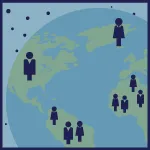Social Development Indicators Factsheet
Standards of living are difficult to measure, but indicators of social development are available. A basic measure, per capita Gross Domestic Product (GDP), is the value of all goods and services produced within a region over a given time period, averaged per person. A more advanced metric, the Human Development Index (HDI), considers life expectancy, education, and Gross National Income (GNI). The three highest HDI-ranked countries are Switzerland, Norway, and Iceland.1 Many of the indicators discussed below are used to measure progress towards the Sustainable Development Goals (SDGs), a set of targets agreed upon by United Nations member states as crucial for global human progress.
Population
- The 2023 U.S. population is 334 million and world population is over 7.9 billion.2
- Global population is projected to reach 9.8 billion by 2050. An estimated 6.7 billion people will be living in urban areas—a 68% increase from 2015.3
- The population of Sub-Saharan Africa is growing rapidly and may exceed 3 billion people by 2100. By 2070 it is projected to become the most populated region in the world.4
- Significant issues affecting population include shifting mortality and fertility rates, international migration, gender equality, and impacts of the COVID-19 pandemic.4
- Fertility rate, or number of births per woman (of child-bearing age), is projected to fall from a global average of 2.3 in 2021 to 2.1 by 2050. Currently, Niger has the highest fertility rate at 7.0; the U.S. fertility rate is 1.8.4,5
- Life expectancy averages 64 years in Least Developed Countries (LDC); life expectancy at birth in the U.S. is 76 years.6
- Globally, contraceptive use is increasing. In 2020, global contraceptive use was 1.7 times higher than in 1990 and was 6 times higher in LDC than in 1990.7 However, more than 20% of women of reproductive age in 15 countries still do not have access to contraceptives.8
World Population, Urban and Rural, 1950-20503

Standard of Living
- For the first time in 20 years, global extreme poverty rose in 2020—a result of the COVID-19 pandemic and Russia’s invasion of Ukraine. By the end of 2030, 7% of the world’s population (574 million people) will live in extreme poverty.9
- In 2021, 11.6% of the U.S. population—37.9 million people—were living in poverty (income under $27,479 for a family of 4 with 2 children).10 Black, Hispanic, and Native American populations in the U.S. face higher than average levels of poverty (19.5%, 17.1, and 24.2%, respectively).10
- According to the Gini Coefficient, Slovakia, Slovenia, and Belarus have among the most equal income distributions in the world. There are over 100 countries a with more even income distribution than the U.S. (Gini coefficient = 41.5).1
- More than 582,462 people experienced homelessness at some point in the U.S. in 2022.11
Food (See U.S. Food System Factsheet)
- Average expenditures on food as a percentage of income range from 14% in developed countries to 30% in developing countries in 2021.13,14 On average, Americans spend 7%, while Nigerians spend 59%.13
- Globally, 45% of deaths of children under age five are caused by undernutrition.15
- The Green Revolution during the second half of the 20th century led to large increases in agricultural yields and helped feed the rapidly growing global population. Sub-Saharan Africa was the only developing region where increased food production was primarily due to increased crop area vs. increased crop yield.16
- The United Nations Food and Agriculture Organization publishes a comprehensive set of food security statistics annually.17
Fraction of Population Undernourished, 202112
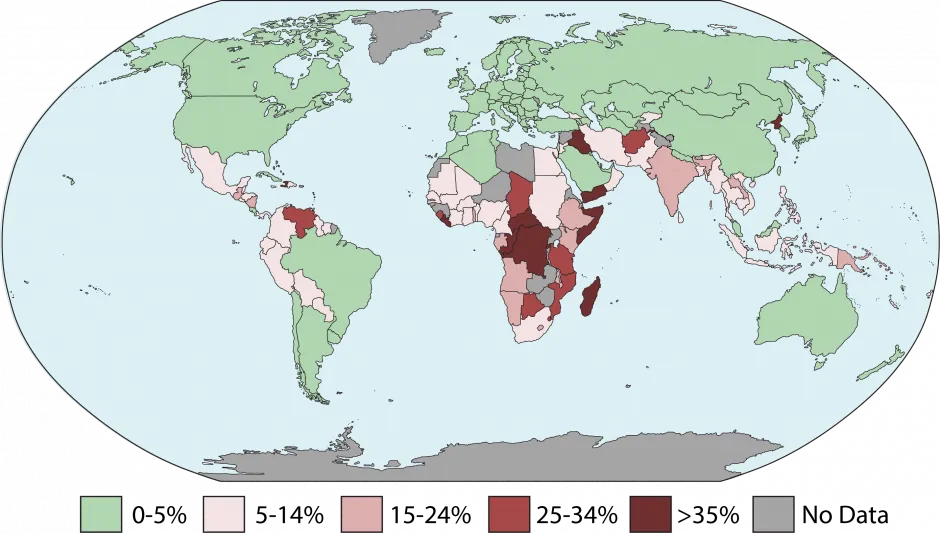
Water and Sanitation (See Factsheets Related to Water)
- Approximately 1.7 billion people lack access to proper sanitation. Access is lowest in sub-Saharan Africa, where only one in four people have proper facilities. Worldwide, urban areas have better sanitation coverage—88% have access to proper facilities, compared to 66% in rural areas.19
- Only 37% of people in LDCs have access to basic hygiene (soap and water).19
- In 2020, 74% of the world population had access to clean drinking water at home, but 282 million people spent more than 30 minutes per round trip to collect safe drinking water. In Oceania and Sub-Saharan Africa only 47% and 49% of the rural populations, respectively, have access to improved water resources.19
Deaths from Unsafe Water and Sanitation, 201918
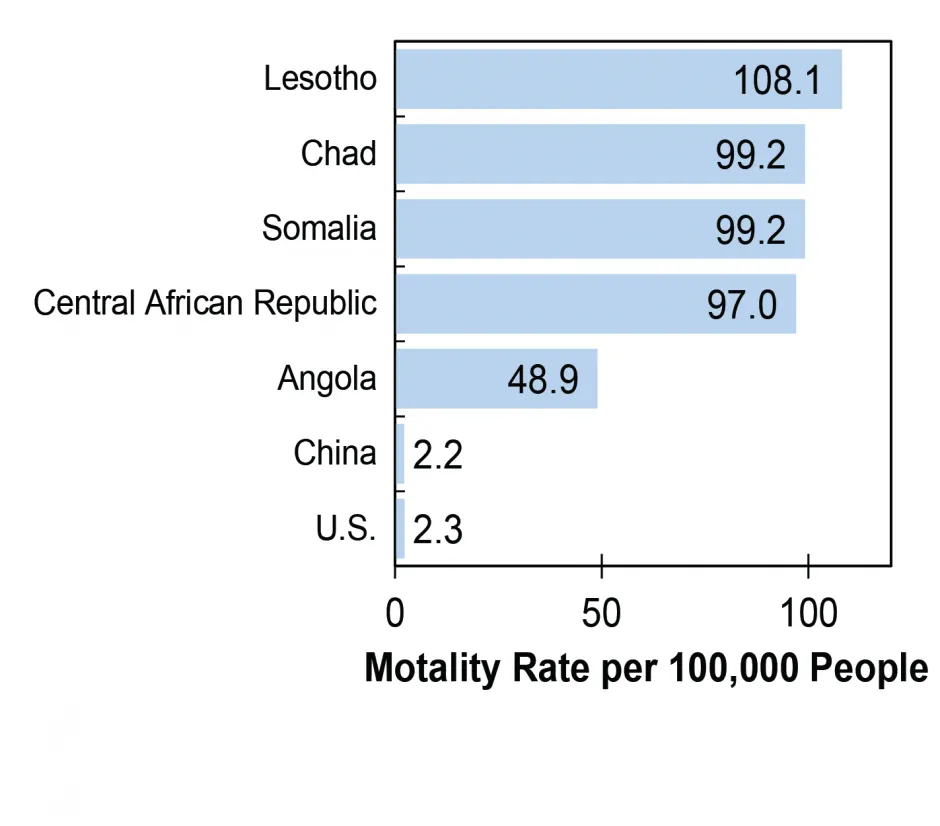
Healthcare and Disease
- Approximately 26% of deaths in 2019 were caused by communicable diseases.20
- Globally, 38 million people were infected with HIV and 680,000 died from AIDS in 2020. Most cases—20.6 million—were in eastern and southern Africa. The number of new infections declined by 31% between 2010 and 2020, but infection rates have increased in northern Africa, the Middle East, and Latin America.21
- Diarrheal diseases killed 1.6 million people in 2016 due to inadequate water, sanitation, and hygiene services. Each year 446,000 children die from diarrhea. Greater than 70% and 55% of the infections are due to unsafe drinking water and sanitation, respectively.22
- In 2021, there were 247 million cases of malaria worldwide, with 95% occurring in Africa; 619,000 people died and 76% of malaria cases in children under 5 resulted in death.23 Research shows more populations will be at risk of malaria as climate change expands suitable habitat for disease-carrying mosquitoes.24 Malaria mortality rates have decreased by more than 50% globally since 2000.23
- Indoor air pollution, primarily from smoke while cooking, contributes to 3.2 million premature deaths each year.25
- Cardiovascular diseases are the leading cause of death in the world. A healthy diet, regular physical activity, and avoiding tobacco could reduce the major risk factors associated with premature deaths from cardiovascular diseases and strokes.18
- COVID-19 has become a leading cause of death. Preliminary WHO estimates suggest at least 6.9 million deaths globally as of 2023.18 COVID-19 was also responsible for 14.9 million excess deaths and 336.8 million years of life lost globally by the end of 2021.18
- In 2015, about 90 million people fell below the poverty line due to out-of-pocket health care costs.26
Development Assistance for Health to Developing Nations27
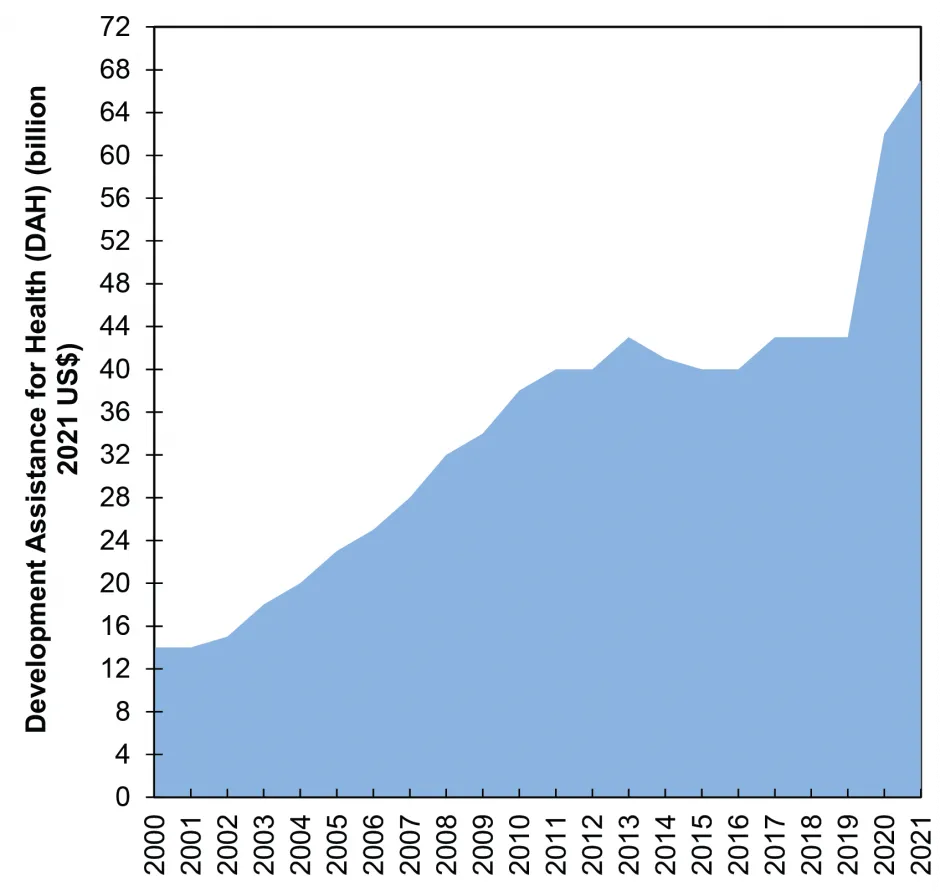
Education and Employment
- Global youth literacy has risen from 83% in 1990 to 92% in 2020. The gap in female and male literacy rates is also closing; in 1990, literacy rates were 87% and 80% for boys and girls, respectively. In 2020, the literacy rates were 93% and 91%.30
- Marshall Islands spends the highest percentage of its GDP on education, devoting on average 16% annually over the last decade. The U.S. spends around 5% annually.31
- Sub-Saharan Africa primary school enrollment increased from 52% to 80% from 1990-2015; the 2015 world average is 91.5%.32
- In Low Human Development nations, 25% percent of the population has at least some secondary education. In Very High Human Development nations this metric is 89%.33
- Most jobs in developing countries are in agriculture (60%), services (27%), and industry (13%).34
Adult Literacy Rates, 201828,29
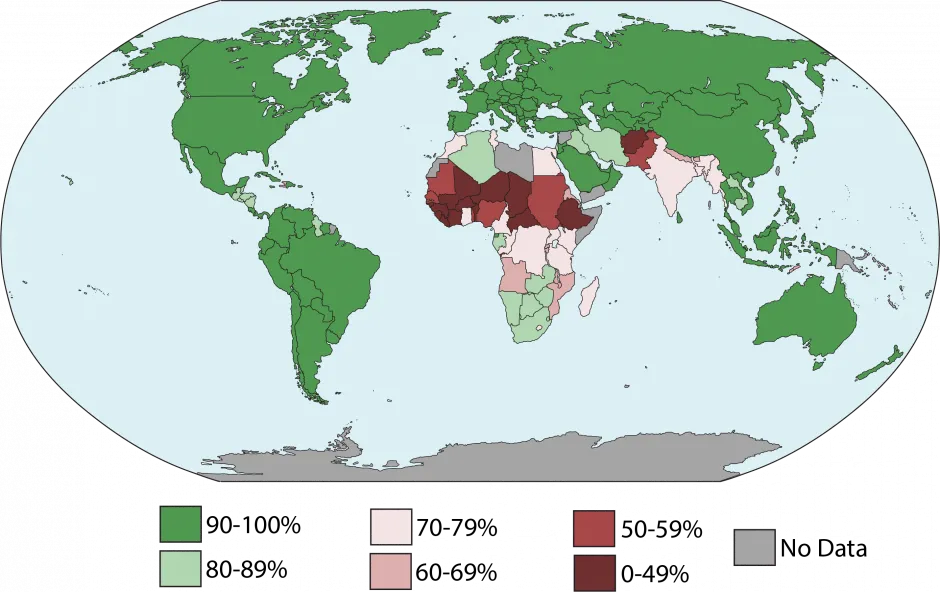
Environment
- In 2023, the Intergovernmental Panel on Climate Change (IPCC) concluded that anthropogenic greenhouse gas emissions and human activities have unequivocally caused climate change.35
- In the 21st century, climate change will likely result in increasing extinction risk for plant and animal species, more flooding and coastal erosion, extreme heat, droughts, tropical storm intensity, and human health risks associated with malnutrition and water-related and vector-borne diseases. Declines in crop productivity in low latitudes and freshwater availability are likely. Poor communities are especially vulnerable because of their low adaptive capacity and high dependence on local climate (e.g., rain for agriculture).36
- A 2019 analysis found that not investing in climate change mitigation would result in an average 7.2% decrease in global GDP by 2100 while adhering to the Paris Agreement could limit this decrease to 1.1%.37
Global Initiatives
- In 2015, the UN established seventeen Sustainable Development Goals (SDGs), including eliminating poverty and hunger, reducing inequalities, and improving health and education while ensuring environmental sustainability.38
- Through 2019, Denmark, Luxembourg, Norway, Sweden, and the United Kingdom continued to exceed giving 0.7% of their GNI as Official Development Assistance (ODA), an Organisation for Economic Cooperation and Development (OECD) program. The U.S. donates a lower percentage of GNI, but the greatest absolute dollar amount of any nation. In 2019, U.S. ODA totaled $34.6 billion.39
Center for Sustainable Systems, University of Michigan. 2023. "Social Development Indicators Factsheet." Pub. No. CSS08-15.
References
- United Nations (UN) Development Programme (2022) Human Development Report 2021/2022.
- U.S. Census Bureau (2023) U.S. and World Population Clock.
- UN Population Division (2018) World Urbanization Prospects: 2018 Revision.
- UN (2022) World Population Prospects 2022 Summary of Results.
- UN Population Division (2019) World Population Prospects 2019.
- The World Bank (2022) Life Expectancy.
- UN Population Division (2020) “Estimates and Projections: Regions.”
- UN Population Division (2020) “Estimates and Projections: Countries.”
- The World Bank (2022) “Poverty and Shared Prosperity 2022: Correcting Course.”
- U.S. Census Bureau (2022) Poverty in the United States: 2021.
- U.S. Department of Housing and Urban Development (2022) The 2022 Annual Homeless Assessment Report (AHAR) to Congress, Part 1: Point-in-time Estimate of Homelessness.
- World Food Programme (2021) Hunger Map 2021.
- U.S. Department of Agriculture (USDA), Economic Research Service (ERS) (2022) International Consumer and Food Industry Trends - Expenditures on food in selected countries.
- UN (2021) World Economic Situation and Prospects 2021.
- Black, R., et al. (2013) “Maternal and child undernutrition and overweight in low-income and middle-income countries.” The Lancet, 382(9890):396.
- Pingali, P. (2012) “Green Revolution: Impacts, Limits, and the Path Ahead.” Proceedings of the National Academy of Sciences, 109 (31): 12302-12308.
- UN Food and Agriculture Organization (2022) The State of Food Security and Nutrition in the World 2022.
- World Health Organization (WHO) (2023) World Health Statistics 2023.
- WHO (2021) Progress on Drinking Water, Sanitation and Hygiene - Five Years Into The SDGs.
- World Health Organization (WHO) (2022) World Health Statistics 2022
- UN (2021) UNAIDS Data 2021.
- GBD 2016 Diarrhoeal Disease Collaborators (2018) “Estimates of the global, regional, and national morbidity, mortality, and aetiologies of diarrhoea in 195 countries: a systematic analysis for the Global Burden of Disease Study 2016.” The Lancet Infectious Diseases 2018;(18)1211-1228.
- WHO (2021) World Malaria Report 2021.
- Caminade, C., et al. (2014) “Impact of climate change on global malaria distribution. Proceedings of the National Academy of Sciences.” 111(9), 3286–3291.
- WHO (2022) “Household Air Pollution.”
- WHO (2020) World Health Statistics 2020.
- Institute for Health Metrics and Evaluation (2023) Financing Global Health.
- UNESCO Institute for Statistics (UIS) (2020) Education: Literacy Rate.
- U.S. Central Intelligence Agency (2020) World Factbook - Literacy.
- UIS (2021) Education: Youth Literacy Rate.
- The World Bank (2020) Government Expenditure on Education.
- UN (2015) Millennium Development Goals Report 2015.
- UN Development Programme (2018) Human Development Indices and Indicators 2018 Statistical Update.
- UNCTAD (2018) Statistical Tables on the Least Developed Countries - 2018.
- Intergovernmental Panel on Climate Change (IPCC) (2023) Climate Change 2023 Synthesis Report Summary for Policymakers.
- World Meteorological Organization (2021) State of the Global Climate 2020.
- National Bureau of Economic Research (2019) Long-term Macroeconomic Effects of Climate Change: A Cross-Country Analysis.
- UN (2020) Sustainable Development Goals.
- Organisation for Economic Co-operation and Development (2019) Official Development Assistance 2019 – Preliminary Data.
